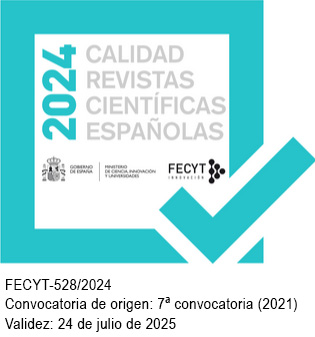¿Oraciones finales insubordinadas en griego antiguo?
doi: https://doi.org/10.31810/rsel.55.1.7
Palabras clave:
Oraciones finales; insubordinación; griego arcaico; griego clásicoResumen
El presente trabajo se propone indagar si, como en griego postclásico, hay oraciones finales insubordinadas en griego arcaico y clásico. Para ello se han analizado las oraciones finales de ἵνα, ὡς, ὅπως y ὄφρα de Homero, Esquilo, Sófocles, Eurípides, Aristófanes y Menandro.
No se han encontrado ejemplos inequívocos de finales insubordinadas, pero sí ejemplos de lo que parece ser la fuente de la construcción insubordinada. Los hay de dos clases. Una clase está integrada por oraciones finales sin supraordinada que configuran la segunda parte de un par adyacente de orden/rechazo y cuya supraordinada se puede reconstruir solo parcialmente.
La otra está representada por oraciones finales que pueden interpretarse como insubordinadas o como subordinadas de contraste, es decir, como finales que expresan la ruptura de una expectativa. La imposibilidad de conocer la entonación con que eran pronunciadas impide la desambiguación
Descargas
Citas
Bartolo, G. di (2022). The μὴ ἵνα + Subjunctive Construction in Greek Documentary Papyri. Glotta, 98, 136-147. doi: https://doi.org/10.13109/glot.2022.98.1.136
Beijering, K., Kaltenböck, G. y Sansiñena, M. S. (2019). Insubordination: Central Issues and Open Questions. En K. Beijering, G. Kaltenböck y M. S. Sansiñena (Eds.), Insubordination. Theoretical and Empirical Issues (pp. 1-28). De Gruyter.
Benedetto, V. Di (1965). Euripidis Orestes. Introduzione, testo critico, commento e appendice metrica. La Nuova Italia Editrice.
Bybee, J. (2013). Usage-based Theory and Exemplar Representations of Constructions. En T. Hoffmann y G. Trousdale (Eds.), The Oxford Handbook of Construction Grammar (pp. 49-69). Oxford University Press.
Clayman, S. E. (2013). Turn-Constructional Units and the Transition-Relevance Place. En J. Sidnell y T. Stivers (Eds.), The Handbook of Conversation Analysis (pp. 150-166). Wiley-Blackwell.
Collard, C. (2018). Colloquial Expressions in Greek Tragedy. Revised and Enlarged Edition of P. T. Stevens’s Colloquial Expressions in Euripides. Franz Steiner Verlag.
Denniston, J. D. (1954). The Greek Particles (2ª ed.). Oxford Clarendon Press.
D’Hertefelt, S. (2018). Insubordination in Germanic. A Typology of Complement and Conditional Constructions. De Gruyter.
Evans, N. (2007). Insubordination and its Uses. En I. Nikolaeva (Ed.), Finiteness: Theoretical and Empirical Foundations (pp. 366-431). Oxford University Press.
Evans, N. y Watanabe, H. (2016). The Dynamics of Insubordination. An Overview. En N. Evans y H. Watanabe (Eds.), Insubordination (pp. 1-37). John Benjamins.
Galán Rodríguez, C. (1999). La subordinación causal y final. En I. Bosque y V. Demonte (Dirs.), Gramática descriptiva de la lengua española (vol. III, pp. 3596-3642). Espasa.
Goodwin, W. W. (1897). Syntax of the Moods and Tenses of the Greek Verb. Ginn & Company.
Grande Alija, F. J. (2020). Para que luego digan…: de la sintaxis oracional al discurso. Rilce. Revista de Filología Hispánica, 36(3), 1045-1072. doi: https://doi.org/10.15581/008.36.3.1045-72
Halliday, M. A. K. y Hasan, R. (1976). Cohesion in English. Longman.
Heine, B. (2002). On the Role of Context in Grammaticalization. En I. Wischer y G. Diewald (Eds.), New Reflections on Grammaticalization (pp. 83-101). John Benjamins.
Heine, B., Kaltenböck, G. y Kuteva, T. (2016). On Insubordination and Cooptation. En N. Evans y H. Watanabe (Eds.), Insubordination (pp. 39-63). John Benjamins.
Kaltenböck, G., Heine, B. y Kuteva, T. (2011). On Thetical Grammar. Studies in Language, 35(4), 848-893. doi: https://doi.org/10.1075/sl.35.4.03kal
Kaltenböck, G. (2019). Delimiting the Class: A Typology of English Insubordination. En K. Beijering, G. Kaltenböck y M. S. Sansiñena (Eds.), Insubordination. Theoretical and Empirical Issues (pp. 167-198). De Gruyter.
Kitzinger, C. (2013). Repair. En J. Sidnell y T. Stivers (Eds.), The Handbook of Conversation Analysis (pp. 229-256). Wiley-Blackwell.
Kühner, R. y Gerth, B. (1898). Ausführliche Grammatik der griechischen Sprachen. Zweiter Teil: Satzlehre (vol. I). Hansche.
Labiano Ilundain, M. (2023). Griego antiguo εἰ μὴ… γε. Respuesta no preferida replicativa e insubordinación. Cuadernos de Filología Clásica. Estudios griegos e indoeuropeos, 33, 69-105. doi: https://doi.org/10.5209/cfcg.84742
La Roi, E. (2021). The Insubordination of If- and That-Clauses from Archaic to Post-Classical Greek: A Diachronic Constructional Typology. Symbolae Osloenses, 95(1), 2-64. doi: https://doi.org/10.1080/00397679.2021.1951005
La Roi, E. (2022). Insubordination in Archaic and Classical Latin: Commands, Requests, Wishes and Assertives. Journal of Latin Linguistics, 21(1), 23-45. doi: https://doi.org/10.1515/joll-2022-2008
La Roi, E. (2024). The Impact of Insubordination on the History of Greek. Cross-Linguistic Connections, Morphosyntactic Innovations and Pragmatic Spread in the Modal System. Journal of Greek Linguistics, 24(2), 290-322. doi: https://doi.org/10.1163/15699846-02402004
La Roi, E. (En prensa). Between Dialogic and Diachronic Syntax: The Insubordination of Directive ὅπως in Classical Greek Drama. En R. Verano (Ed.), Conversation Analysis and Classics. Talk-in-Interaction in Greek and Latin Literature. Brill.
López Romero, M. (2023). Oraciones de relativo en el drama ático clásico [Tesis doctoral, Universidad de Sevilla].
López Romero, M. (2024). Oraciones desobedientes: insubordinación en griego antiguo. Estudios Clásicos, 166, 53-68.
Martínez Vázquez, R. (2014). Purpose Clauses. En G. K. Giannakis (Ed.), Encyclopedia of Ancient Greek Language and Linguistics (vol. 3, pp. 194-197). Brill.
Mastronarde, D. J. (1979). Contact and Discontinuity. Some Conventions of Speech and Action on the Greek Tragic Stage. University of California Press.
Mastronarde, D. J. (1994). Euripides. Phoenissae. Edited with Introduction and Commentary. Cambridge University Press.
Mithun, M. (2008). The Extension of Dependency beyond the Sentence. Language, 84(1), 69-119. doi: https://doi.org/10.1353/lan.2008.0054
Monro, D. B. (1891). A Grammar of the Homeric Dialect (2ª ed.). Oxford Clarendon Press.
Olson, S. D. (1998). Aristophanes. Peace. Oxford Clarendon Press.
Pearson, A. C. (1909). Euripides. The Phoenissae. Cambridge University Press.
Revuelta Puigdollers, A. (2020). Las oraciones finales y consecutivas. En M. D. Jiménez López (Coord. Ed.), Sintaxis del griego antiguo (vol. 2, pp. 899-939). Consejo Superior de Investigaciones Científicas.
Ruiz Yamuza, E. (2021). No es subordinado todo lo que lo parece. En J. de la Villa et al. (Eds.), Forum classicorum. Perspectivas y avances sobre el mundo clásico (pp. 283-316). Guillermo Escolar.
Ruiz Yamuza, E. (2022). Parenthetical Conditionals and Insubordinate Clauses in Ancient Greek. Protasis with βούλομαι (boúlomai) and (ἐ)θέλω (ethélō). Journal of Greek Linguistics, 22(2), 232-259. doi: https://doi.org/10.1163/15699846-02202002
Ruiz Yamuza, E. (2024). Prótasis interrogativas en griego antiguo desde la perspectiva de la teoría de la insubordinación y el análisis de la conversación. Emerita, 92(1), 1-20. doi: https://doi.org/10.3989/emerita.2024.1270
Schegloff, E. A. (2007). Sequence Organization in Interaction. A Primer in Conversation Analysis. Cambridge University Press.
Sidnell, J. (2010). Conversation Analysis. An Introduction. Wiley-Blackwell.
Sommerstein, A. H. (1985). The Comedies of Aristophanes. Vol. 5: Peace. Aris & Phillips.
Verstraete, J.-C. y D’Hertefelt, S. (2016). Running in the Family. Patterns of Complement Insubordination in Germanic. En N. Evans y H. Watanabe (Eds.), Insubordination (pp. 65-87). John Benjamins.
Wakker, G. (1994). Conditions and Conditionals. An Investigation of Ancient Greek. J. C. Gieben.
Willink, C. W. (1986). Euripides. Orestes. Oxford University Press.
Publicado
Cómo citar
Número
Sección
Derechos de autor 2025 Revista Española de Lingüística

Esta obra está bajo una licencia internacional Creative Commons Atribución-NoComercial-SinDerivadas 4.0.










